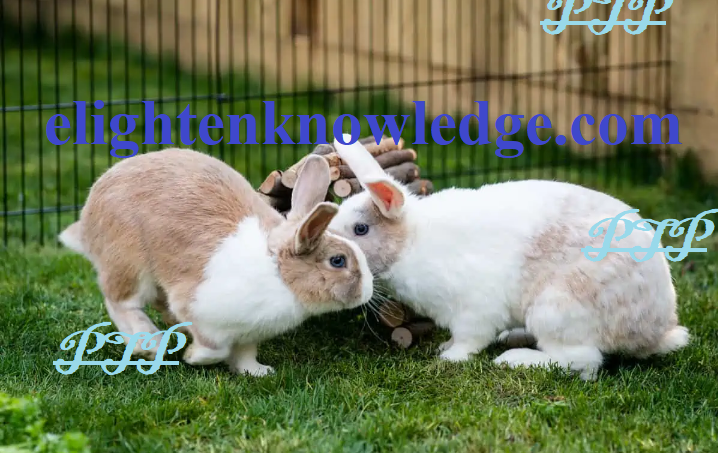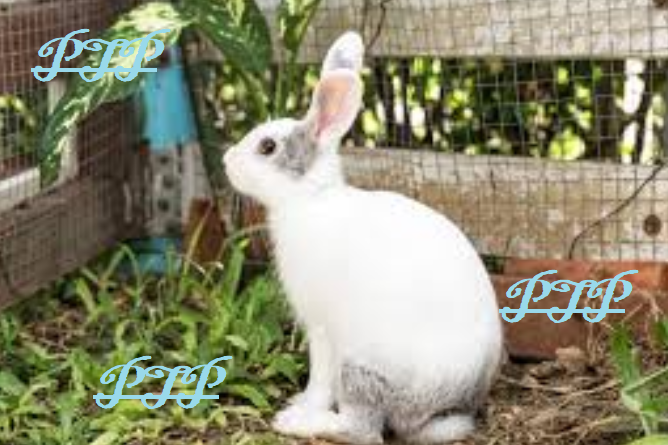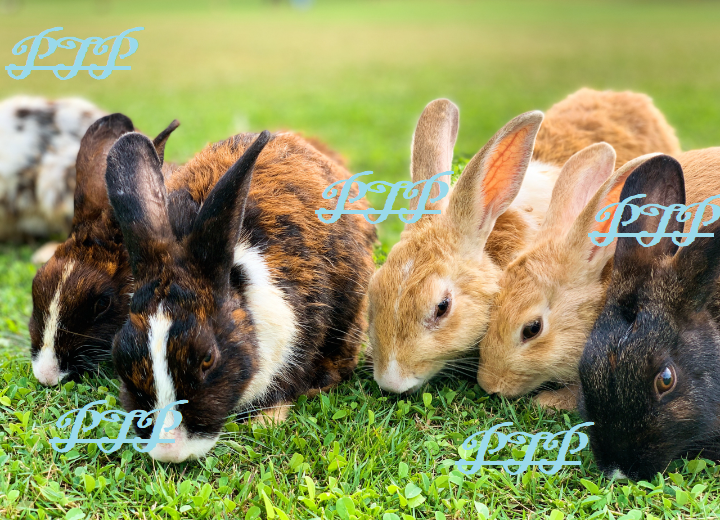Rabbit Production in Ghana.

Rabbit Production in Ghana.
Content;
- Rabbit and its importance
- General characteristics of rabbits
- Some common breeds of rabbits
- How to select a good breed of rabbit for rearing
- Reproduction and taking care of rabbits from birth to maturity
- Diseases and pests that affect rabbits, and how to control them.
- Marketing of rabbit products
- Problems associated with rabbit production in Ghana
Rabbit and its importance
- Rabbits are monogastric or non-ruminant animals.
- They are medium-sized mammals with long ears and short tails.
- They are mainly reared for their meat.
- Rabbits are highly prolific and productive herbivore that efficiently converts fodder and other feeds as meat.
- Rabbits are easy to care for in terms of feeding, housing, and disease and pest control.
Importance of Rabbit
- Rabbits provide man with excellent meat.
- Rabbits are used for research purposes.
- Rabbits provide manure to improve the fertility of soil.
- Rabbit skin or pelt can be used for making jackets, carpets, and other decorative households or ornamentals.
- For fur production.
- As domestic pets.
General Characteristics of Rabbits
- Rabbits have small medium-sized bodies.
- Rabbits are very prolific animals or can produce many litters.
- Rabbits are very easy to house.
- They are efficient converters of fodder and other feeds to food.
- Rabbits are easy to handle or manage.
- They have a weaning period of six to eight weeks.
- They are susceptible to stress.
- The rate of cannibalism is very high.
- They have a high rate of disease resistance.
- They make good quality meat, more delicious and nutritious than chicken.
- The fur-covered skins can be processed as pelts for sale.
- They have a short gestation period of 30-31 days.
Common breeds of rabbit
Many rabbit breeds have emerged due to the prolific nature of rabbits.
In Ghana, several exotic breeds are raised for meat as it is the main product in the country.
The local breeds are smaller than the exotic ones but they are better adapted to the tropics, some of the breeds of rabbit are as follows:
- California White
- New Zealand White
- Chinchilla
- Angora
- Blue Beveren
- The Dutch
- Polish rabbit
- Florida White
- Lilac
- Rex
- Cinnamon
- Continental giant.
- Flemish giant
- French lop
- New Zealand red
- French Havana
- Rose
- Beveren
- Chin Ginganta
- Havana
- Lop
- Spanish (Gaint)
- Silver
Common Terms Used In Rabbit Production.
Buck: It is an adult male rabbit
Doe: It is an adult female rabbit
Hutch: It is the house of rabbits.
Kitten/warren/ fryers: is a young rabbit
Kidding: is the act of parturition in a rabbit.
Pelt: the skin of a rabbit.
Litter: all the young ones (rabbits) produced at the same time by one doe.
Sucking: feeding of young ones on the mother’s breast milk.
Dam: the mother of a set of young rabbits.
Sire: the father of a set of young rabbits
Reproduction and Development
- The adult doe does not have any particular heat period.
- The presence of a buck could stimulate the doe to come on heat.
- The gestation period of the doe is 31 days.
- Before Kidding, nest boxes and bedding materials are provided for the doe in the hutch.
- The doe can give birth to four to eight litters at a time.
- The young ones are fed first with colostrum and after two to three days on milk produced by the doe.
- After about four to eight weeks, the young rabbits (fryers) are weaned and they will start to feed on solid food and green feed as well.
- Growth is rapid and in the absence of diseases and parasites, coupled with good feeding programs and management, the rabbit will mature after attaining 4-5 kg at four to six months of age.
- Rabbits should never be lifted by their ears or legs as that might permanently injure them.
- Small rabbits or fryers may be lifted and carried comfortably without hurting them by grasping the loin (between the hips and ribs), with the heel of the hand towards the tail of the animal.
- For heavy rabbits, grasp a fold of skin over the shoulder and lift, holding the rabbit against the body with its head under an arm, the forearm being extended along the side of the animal and the head under its rump for support.
- This prevents struggling and the rabbit may be carried comfortably.
Stages involved in the reproduction and development of rabbits.
Breeding
The national Rabbitry at Nungua Farms is one of the main sources of raising breeding stock in Ghana.
It is important to select rabbits that will produce large numbers of healthy bunnies over a long period (i.e., good longevity) with minimum use of food.
Qualities to be considered in selecting rabbits for breeding
- Healthy and vigorous.
- Fertility and activeness.
- Growth rate.
- The doe must show good mothering ability to raise a large litter.
- Ability to live long.
- Disease resistance.
- Good body size and shape.
- Both doe and buck should have no deformities in their reproductive organs.
- The buck should have a sound scrotum with two well-developed palpable balls or testicles.
Mating
- Both the buck and doe are considered mature for mating at the age of 5 to 7 months.
- To prevent inbreeding, the buck in a breeding stock should be replaced after some time with an equally good one. This is to prevent the buck from mating its own female offspring.
- One buck is capable of serving 10 – 20 does in a breeding program.
- The doe does not exhibit a regular reproductive cycle (heat period).
- Experience will enable a keeper or attendant to detect the doe’s heat period from its behavior.
- The presence of a buck could stimulate the doe to come on heat.
- The heat period comes on after every 15 – 17 days unless the doe is pregnant.
- During mating, the buck should not be taken to the doe but rather the doe should be sent to the buck in its hutch. This is because the ‘does’ do not mate in their hutch.
- Successful mating may be detected from the doe as the skin around the reproductive organ tends to carry a whitish jelly-like liquid or juice.
- It is possible to use a buck for servicing several times a day, but it is best to allow one to two mating activities a day for the buck to keep its health during the breeding season.
- The presence and activity of the buck can stimulate the doe to come on heat. The doe can therefore be sent to the buck for mating even when no sign of heat is seen in it.
The signs of the heat of rabbit
- Swelling of reproductive organs.
- Restlessness and aggressiveness.
- Rubbing of its body against the feeding container and the hutch wall.
- Jumping about trying to get into contact with the rabbit in the adjoining nest.
- ‘Does’ in groups may tend to ride on one another when they are on heat.

Read more:
-
Horses, types, and ways to take care of horses
-
The Principles of Canning and How to Can Your Food At Home.
-
Integrated Science for Senior High Schools, BIOTECHNOLOGY.
Pregnancy
- A pregnant doe will reject the buck when sent for mating.
- The doe increases in weight and develops more.
- The doe may also turn the drinking container after drinking some of the water.
- The doe may often hide in corners of the hutch.
- Pregnancy in does’ can be detected by palpating the side under the stomach (lower abdomen) with the fingers from about two weeks after the date of mating.
- Sometimes copulation does not result in pregnancy, false pregnancy may occur lasting for about 18 days.
- Does exhibiting false pregnancy generally start making nests and secrete milk within 20 days from the date of mating?
- Such does should be taken back to the buck for mating again.
Kindling
- Kindling is the act of giving birth or parturition in rabbits.
- The gestation period of the doe is 28 -32 days after mating.
- On average the gestation period is 31 days.
- When kindling or birth is due, the doe will prepare a suitable Kindling bed for the litter in one corner by assembling grass and other materials in the hutch.
- It also lines the bedding material with fur around its teats.
- To enable the doe to make a nest, avoid Kindling on the wire netting floor of the hutch, which may lead to the death of the litter due to pneumonia.
- The kindling box should be lined with grass material (straw) to give a comfortable bed but never use spongy or stringy material which is likely to impair the movement of the bunnies.
- Kindling mostly occurs at night and each young is licked and nursed immediately after it is born until the litter is complete.
Weaning
- The young ones are fed first with colostrum and after two to three days on milk.
- The bunnies or fryers (young rabbits) are weaned after about 4-8 weeks from the date of birth.
- At this age, the young rabbits have enough fur covering their bodies and can eat green grass and other solid food.
- The doe has to be given extra feed during the nursing period and also after weaning to flush it in preparation for mating.
- Mating after weaning can be done after 2 weeks but some farmers do it earlier than 2 weeks.
- As the bunnies or fryers may be left in the breeding cage after the doe has been removed or the bunnies or fryers may be moved to rearing pens,
- Weaning four litters, six litters or nine litters a year is possible.
Sex identification
- The sexes of the rabbit can be determined as early as 2 days after birth but it is easier after 8 weeks when the male and female reproductive organs are well developed.
- The male organ appears as testicles and penis at a distance near the anus.
- On pressing down gently with the index finger and the thumb, the male internal organ may appear to circle with the penis protruding.
- The distance between the anus and the penis is wider in a male than in a female’s anus and the vagina.
- In a female, the vagina is exposed as a slit on pressing the anal region.
- This slit which looks like a V-shape is close to the anus.
Handling
- Handling of the rabbit should be done gently.
- Do not lift the adult by the ears as it causes pain.
- The correct way of lifting an adult rabbit is to hold the loose skin at the back of the neck and support it underneath with one hand.
- Young rabbits can be lifted comfortably without causing damage to the fur or bruising by grasping the loins gently but firmly with the hand.
- Avoid putting rabbits on slippery surfaces since this frightens them.
- Avoid handling rabbits frequently and children should not be allowed to handle rabbits frequently as well.
Housing of rabbits
- Rabbits are usually kept in hutches.
- The hutches are arranged in single, double, or triple tiers.
- The waist-high, single-tier hutches are preferable because they save time and labor in feeding and management.
- Wooden or metal hutches with wire-netting surroundings are widely used.
- The hutches are placed under a building usually referred to as rabbitry.
- The rabbitry must be well-ventilated.
- The floor of the rabbitry should be made with concrete for easy cleaning.
- The roof should be made with corrugated iron sheets or asbestos sheets.
- The hutches can also be placed in a poultry-deep litter house.
- The males are kept separate from the females within the rabbitry.
- Legs of hutches should be placed in disinfectant bowls to keep off termites and other insect attacks.
Feeding
- Rabbits are simple stomach herbivores, i.e., they feed mainly on plants.
- Rabbits are given concentrates in the form of pellets in small quantities.
- The pellets given can be supplemented with Aspilia africana, sweet potato leaves, Amarantus, Waterleaf, Centrosema spp, Emilia spp, Tridax spp, Calopogonium spp, and many others.
- Rabbits can be given poultry grower’s mash in the absence of rabbit pellets. This should, however, be sprinkled with water to prevent wastage and nasal irritation.
- The protein content of feeds for dry Does and Bucks should be 12-15% while that of pregnant does and nursing does is 16-20%.
- The feed should be served in feeding troughs.
- Water should be supplied all the time.

Also Read:
-
Why dogs never get missing no matter how long they have gone away from home.
-
How to test if your Jute mallow seeds (Ayoyo seed, Ademe seed) is viable for planting.
Hygiene or Health
- Common hygiene or sanitary measures to be adopted include the following:
- Clean the floor of the rabbitry daily.
- Disinfect the rabbitry at regular intervals to keep it germ-free.
- Clean the feed and water troughs to prevent contamination.
- Remove dust and cobwebs from the rabbitry.
- Isolate any sick animal for treatment.
- Remove and bury dead animals.
- Deworm the rabbits at regular intervals.
- Treat the rabbits with drugs such as antibiotics and coccidiostats (Prophylactic).
- Keep the surrounding of the rabbitry weed-free.
- Provide a disinfectant bath or foot dip at the entrance to prevent the introduction of germs into the rabbitry by visitors.
Diseases
Rabbits raised in a clean environment may stay without diseases and pests.
It is therefore necessary to keep the hutch clean; several diseases may attack rabbits including:
- Mastitis (nipple inflammation).
- Hairballs.
- Flystrike
- Sufflies
- Haemorrhagic disease (RHD).
- Calicivirus
- Coccidiosis.
- Colds.
- Ear canker(ear mange) /ear mite.
- Ringworm.
- Sore hock
- Bloat.
- Helminthiasis.
- Uterine.
- Tumour.
- Heat stroke.
- Myxomytosis pneumonia.
- Diarrhoea
- Rabbit pox
- Warbles.
- Wry neck.
- Enteritis.
Pests and parasites
- The following pests and parasites may attack rabbits: fleas, lice, ticks, tapeworms, and mites.
- They can be controlled using recommended pesticides.
- They can be prevented by ensuring cleanliness in the house.
Management practices to be adopted to control diseases and pests
- Regular veterinary services.
- Provide good drinking water.
- The hutch should be cleaned regularly.
- The feeder should be washed.
- Disinfectant should be used.
- Dry feed should be given to the animal.
- Recommended pesticides should be used to control pests.
- Separate sick animals from healthy ones.
Marketing of rabbit products
- Can be sold to producer’s families, neighbours, and people in towns and cities.
- Dressed meat can be sold to hotels, restaurants, supermarkets, drinking bars, and open markets.
- Rabbit khebab could be sold along the streets by vendors.
- Convince people of all walks of life to patronize rabbit meat. This may be done through planned advertising in schools, workplaces (workers canteens), and on radio and television.
- It may be easier to sell cut-up parts than to sell whole-dressed rabbits.
- The market for live rabbits for breeding purposes and the table should also be exposed.
- To encourage efficient delivery of rabbit products, farmers should be encouraged to form both production and marketing cooperatives.
- Such cooperatives are more likely to receive substantial funding from commercial banks to support the development of suitable processing and marketing structures.
Problems associated with rabbit production in Ghana
- Unpredictable breeding behaviour of rabbits.
- Incidence of respiratory diseases.
- Inadequate sanitation and improper sanitation programs.
- It is labour intensive
- Lack of capital also impedes large investments in rabbitary.
- Inadequate supply and high cost of concentrate feeds.
Join Enlighten Knowledge WhatsApp platform.
Join Enlighten Knowledge Telegram platform.





